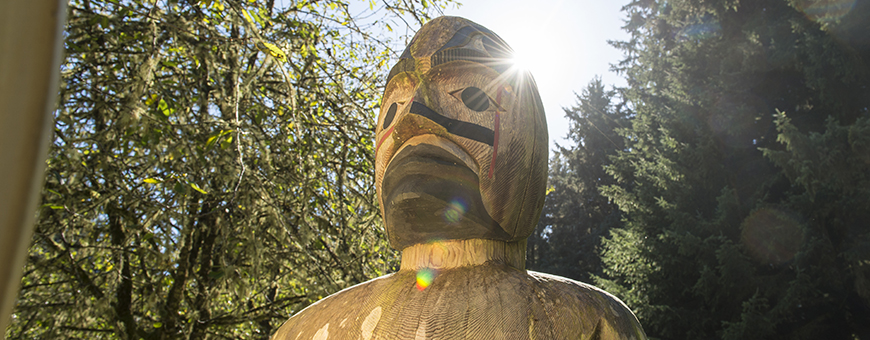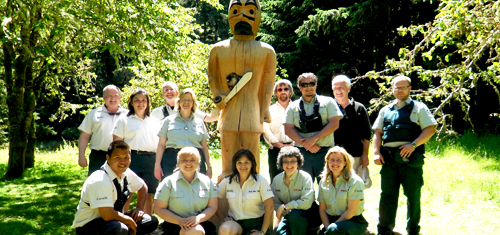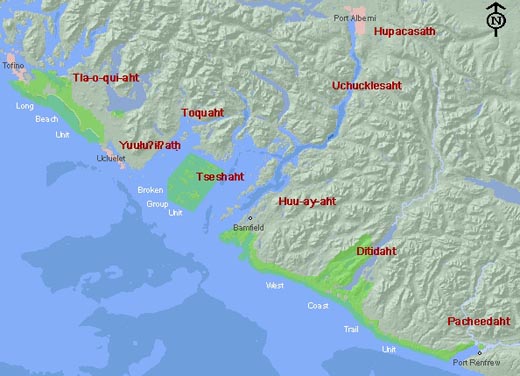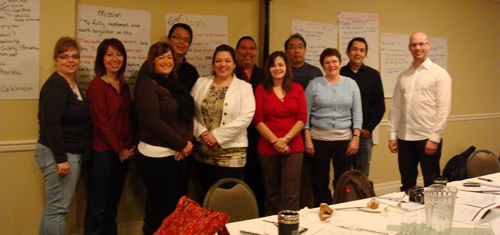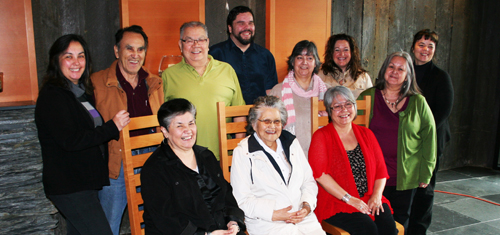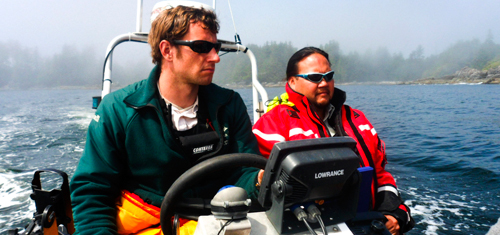First Nations
Pacific Rim National Park Reserve
Working Together | Research | Achievements
Introduction
Pacific Rim National Park Reserve, nestled in the ḥaḥuułi (traditional territories) of the Nuu-chah-nulth people, tells a story of those who have lived here for generations.
Nuu-chah-nulth, or “along the mountains and sea”, refers to the territories along the 300 km stretch of Vancouver Island’s west coast - from Brooks Peninsula in the north to Point-no-Point in the south, and to the Vancouver Island Range in the east.
The resources of this vast ocean and temperate rainforests have traditionally supported the social, cultural and economic well-being of the Nuu-chah-nulth people.
The Nuu-chah-nulth people
Each nation has its own birthplace and creation mythology. The oral traditions of the Nuu-chah-nulth tell of a people who have made their home here for centuries, of a people who were born from this very land.
Historically, the Nuu-chah-nulth were not united as one people but were divided into distinct family or local groups. Each group shared aspects of a language, tradition and culture centered around a ḥaw̓ił (hereditary chief) and lived off the resources that their ḥaaḥuułi (traditional territories) provided them with.
Today, the Nuu-chah-nulth First Nations are composed of 14 individual nations. Each has an elected Chief and Council, as well as ḥaw̓iiḥ (hereditary chiefs) Their culture remains firmly rooted in the land and coastal waters of their ancestry.
The economic, spiritual and social connections to the rainforest, shoreline and ocean may have evolved, but they remain the cornerstones of this enduring west-coast culture.
Parks Canada staff and the Benson Island House Post
The Nuu-chah-nulth First Nations consider the lands within Pacific Rim National Park Reserve as their traditional territory. Since 1995 the park has been working collaboratively with First Nations to achieve long-term conservation and sustainable use of natural and cultural resources within Pacific Rim National Park Reserve. This provides an enriched sense of place for visitors and the local communities.
- Long Beach Unit: Tla-o-qui-aht First Nations, Yuułuʔiłʔatḥ
- Broken Group Islands Unit: Tseshaht First Nation, Toquaht Nation, Hupacasath First Nation, Uchucklesaht Tribe
- West Coast Trail Unit: Huu-ay-aht First Nations, Ditidaht First Nation, Pacheedaht First Nation
- Other: Nuu-chah-nulth Tribal Council
Pacific Rim National Park Reserve falls within the traditional territories of
nine Nuu-chah-nulth Nations
Working Together
Our working relationships are guided by the Nuu-chah-nulth principles of ʔiisaak (respect) and hišukʔiš c̓awaak (everything is one), both of which are integral to the management and operations of the national park reserve.
The key objectives are to ensure:
- First Nation people from the region are represented in all aspects of park management and operations;
- First Nations cultural interpretation is an integral part of the national park reserve's programs;
- Park management is inclusive of Nuu-chah-nulth traditional knowledge;
- Parks Canada and First Nations work towards cooperative management through the development of Cooperative Management Boards ;
- and First Nations understand and support the Parks Canada mandate.
Cooperative Management Boards and Working Groups:
Huu-ay-aht First Nations and the Parks Canada Cooperative Management Board
The national park reserve works with nine Nuu-chah-nulth First Nations through cooperative management boards and working groups.
DEFINITION: Cooperative management describes a management model under which Indigenous groups work together with Parks Canada on the administration of its protected places.
These boards and working groups provide advice, guidance, support and recommendations to the national park reserve on topics, including resource management, visitor experience, planning and economic development. Strong working relationships help ensure mutual interests are respected and considered in decision and policy-making.
Research in collaboration with First Nations
Those proposing to conduct research in Pacific Rim National Park Reserve must adhere to the Parks Canada Research and Collection Permit System application process.
To meet legal requirements, Parks Canada will consult First Nations whose traditional territories lie within the Pacific Rim National Park Reserve and abide by current treaties and agreements. Research permits will only be issued once First Nations have been consulted.
NOTE: Please allow 30 to 90 days to process applications. Urgent applications may be refused due to inadequate time for the cooperative management process to be completed.
Our Achievements
Nuu-chah-nulth Working Group who contributed to the renewal of the Kwisitis Visitor Centre
Through the collaborative efforts of Parks Canada staff and nine Nuu-chah-nulth First Nations, we have accomplished the following:
-
Developed the national park reserves's first Management Plan (PDF, 6.62 MB)
First Nations provided invaluable input into the conservation of ecological and cultural resources and presentation of meaningful and memorable visitor experiences within the national park reserve;
-
Re-designed and re-opened the Kwisitis Visitor Centre
The Nuu-chah-nulth Working Group, comprised of First Nation Elders, leaders and community members, and Parks Canada, designed authentic exhibits for the new
Kwisitis Visitor Centre;
-
Story-telling and interpretive opportunities by Nuu-chah-nulth Guest Speakers
Guest speakers share stories with and deliver presentations to visitors at the Nuu-chah-nulth Trail, Wickaninnish Beach and the Kwisitis Visitor Centre on everything from traditional knowledge to singing and drumming;
-
Established a team of First Nation Guardians and Beach Keepers
Huu-ay-aht, Ditidaht and Pacheedaht Guardians and Tla-o-qui-aht and Tseshaht Beach Keepers deliver First Nations hospitality while ensuring visitors have a safe experience that is respectful of their traditional lands;
Broken Group Island Beach Keepers
-
Ongoing protection of Species at Risk
Parks Canada’s species at risk teams works together with First Nations to monitor and improve habitat for species at risk within the national park reserve and treaty settlement lands. Parks Canada is leading on a number of species at risk programs, including Dromedary Jumping Slug, Pink Sand Verbena, Northern Goshawk, and the Seaside Centipede Lichen;
-
Incorporated the Nuu-chah-nulth language and content into communication materials
The Parks Canada Charter has been translated into all four Nuu-chah-nulth dialects (Northern, Central, Barkley and Southern). You can also explore the language through many of the signs and exhibits throughout the national park reserve.
Related links
- Date modified :
